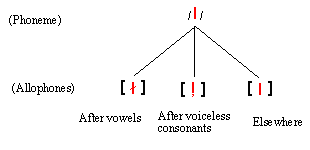3.2 Phonemes and allophones
In phonetic transcription of sounds, the unit of representation is
segment. Looked at from a phonological point of view, some segments distinguish
words, others don't. For example, the two liquids [l]
and [r] distinguish lead and read.
When we listen to more words that contain the lateral liquid, as in deal
and slight, we find the liquid in each of these words is a separate
segment. The one in lead is clear, [l];
the one in deal is dark [![]() ],
and the one in slight is voiceless [
],
and the one in slight is voiceless [![]() ].
These variants are called allophones.
They can be grouped into a phonological unit called a phoneme.
A phoneme is an abstract sound unit. The phonemic symbol is placed between
slashes (/ /). In the case of lateral liquids, [
].
These variants are called allophones.
They can be grouped into a phonological unit called a phoneme.
A phoneme is an abstract sound unit. The phonemic symbol is placed between
slashes (/ /). In the case of lateral liquids, [![]() ]
appears after vowels, [
]
appears after vowels, [![]() ]
after voiceless consonants, and [l] elsewhere.
As [l] is more widely distributed than the
other two, we choose /l/ as the phonemic
symbol. The relation between the phoneme and its allophones can be shown
in the following figure:
]
after voiceless consonants, and [l] elsewhere.
As [l] is more widely distributed than the
other two, we choose /l/ as the phonemic
symbol. The relation between the phoneme and its allophones can be shown
in the following figure:

Segments that are phonemes in one language may be allophones in another.
In English, the two liquids /l/ and /r/ are phonemes, but in Korean the
two segments are allophones. An important part of phonological analysis
deals with how to discover phonemes of a language, a point to which we
turn in the next section.